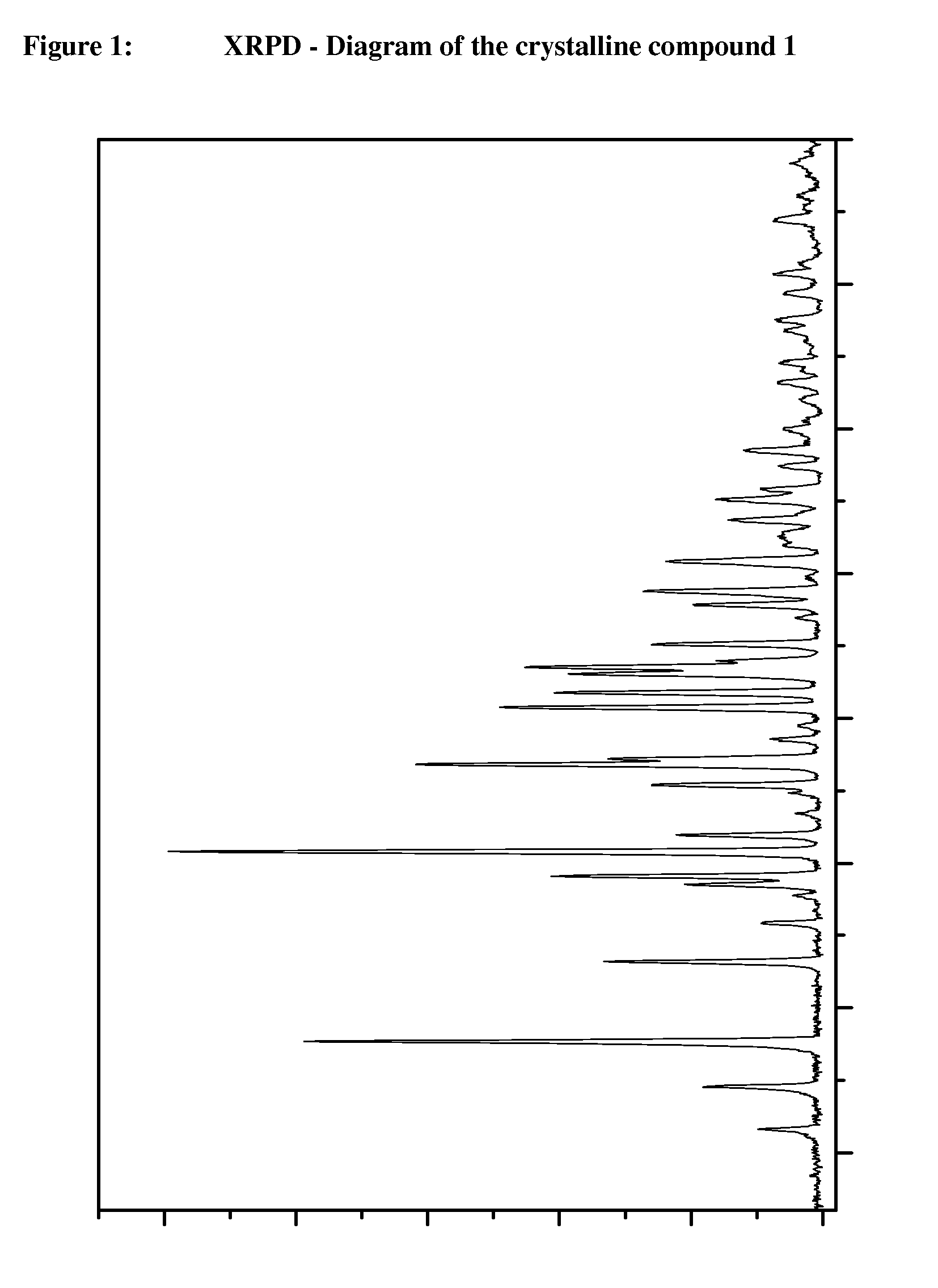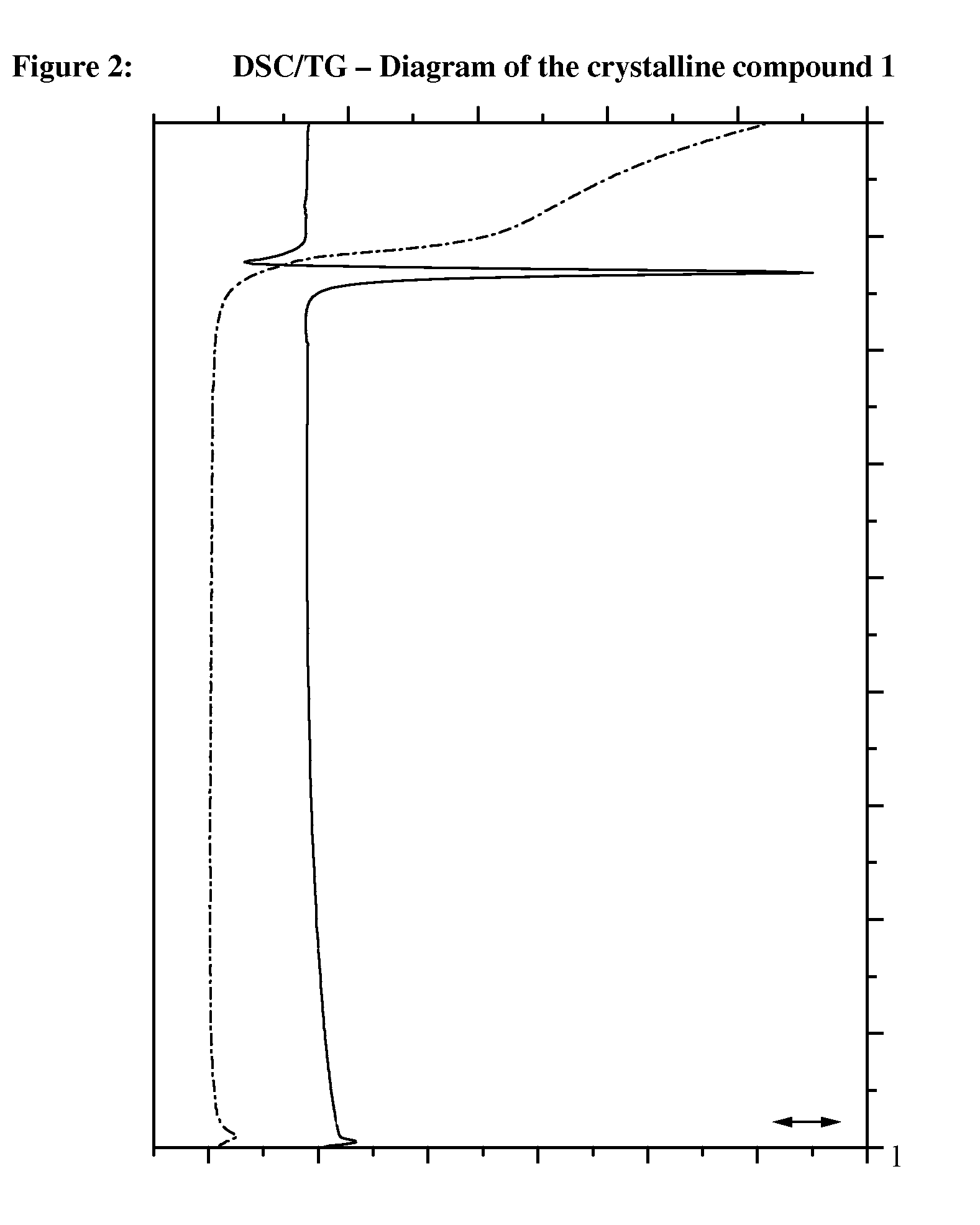Crystalline, enantiomerically pure salt form of a beta-agonist, and the use thereof as a drug
a beta-agonist and enantiomer technology, applied in the direction of biocide, drug composition, aerosol delivery, etc., can solve the problems of stress on the surface, inability to absorb moisture, and reduce the content of pharmaceutically active substances
- Summary
- Abstract
- Description
- Claims
- Application Information
AI Technical Summary
Problems solved by technology
Method used
Image
Examples
example 1
[0073]30 g of compound 2 are suspended in 345 mL acetonitrile and 16.5 mL water.
[0074]At 16-18° C., 6.8 g 30% hydrochloric acid are carefully added, followed by a further 45 mL acetonitrile. The solution is heated to 65° C., activated charcoal is added and the mixture is filtered. The filter cake is washed with 105 mL acetonitrile and the filtrate is refluxed. The solution is evaporated down by distillation, during which time 1 crystallises out. A further 180 mL acetonitrile are added and the distillation is continued. As soon as 250 mL of the solvent has been distilled off, the suspension is cooled to 10° C. and the crystals precipitated are filtered off and washed with 2×60 mL cold acetonitrile. Then the crystals are dried at 50° C. The yield is 29 g (91%).
example 2
[0075]50 g of compound 2 are suspended in 575 mL n-butyl-alcohol. 6.8 g of 30% hydrochloric acid are carefully added to this suspension at ambient temperature, followed by another 20 mL water and a further 75 mL n-butyl-alcohol. The remaining suspension is heated to 80° C. and the solution thus formed is filtered off through activated charcoal. The filter cake is washed with another 225 mL of n-butyl-alcohol. Some of the solvent is distilled off at this temperature, while at the same time a weak vacuum is applied. During this time, some crystallisation of 1 is observed. After 150 mL of the solvent has been eliminated the remaining suspension is cooled to 10° C. and the crystals precipitated are filtered off and washed with 2×100 mL cold n-butyl-alcohol. Then the crystals are dried at 50° C. The yield is 45 g (84%).
[0076]Alternatively the compound 1 according to the invention may also be prepared as follows:
example 3
[0077]2.05 mmol of the free base of the compound of formula 2 are suspended in 7 mL acetone and combined with 506 μl (2.02 mmol) 4 molar hydrochloric acid in 550 μl acetone, whereupon a clear solution is formed. After the addition of a crystallisation aid a total of 7 mL of diethyl ether are added dropwise. The precipitated solid is separated off after 3 hours, washed with diethyl ether and dried at 40° C. Then the solid is recrystallised from acetonitrile with the addition of a few drops of water, filtered and washed again with diethyl ether. Yield: 46%, melting point: 162±3° C.
[0078]500 mg of this intermediate is dissolved in 5 ml acetonitrile and 0.2 mL water at 60° C. The precipitation of the crystals is induced by the addition of crystals as may be obtained for example in Example 1 or Example 2. The mixture is cooled to ambient temperature and stirred for a further 4 hours at this temperature. The crystals precipitated are filtered off, washed with 1 mL acetonitrile 2×1 mL buty...
PUM
| Property | Measurement | Unit |
|---|---|---|
| particle size | aaaaa | aaaaa |
| particle size | aaaaa | aaaaa |
| specific surface area | aaaaa | aaaaa |
Abstract
Description
Claims
Application Information
 Login to View More
Login to View More - R&D
- Intellectual Property
- Life Sciences
- Materials
- Tech Scout
- Unparalleled Data Quality
- Higher Quality Content
- 60% Fewer Hallucinations
Browse by: Latest US Patents, China's latest patents, Technical Efficacy Thesaurus, Application Domain, Technology Topic, Popular Technical Reports.
© 2025 PatSnap. All rights reserved.Legal|Privacy policy|Modern Slavery Act Transparency Statement|Sitemap|About US| Contact US: help@patsnap.com



